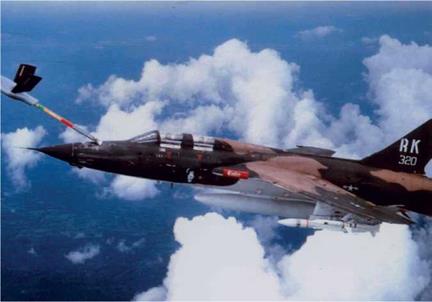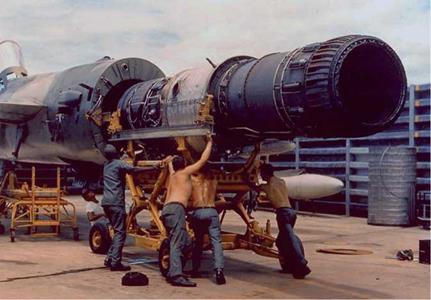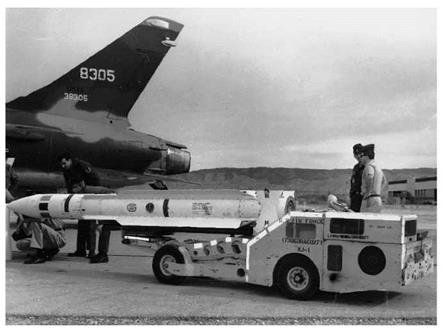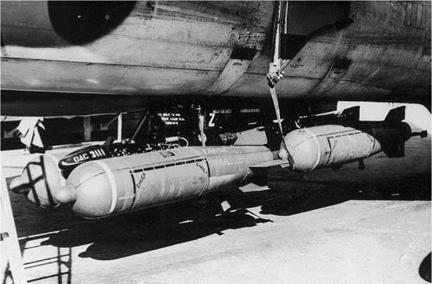SPECIFICATIONS
F-105 WILD WEASEL
As the USAF’s first major SEAD aircraft, the F-105F/G enabled its crews to establish operational techniques for counteracting SAMs that were vital during the Vietnam conflict and still remain valid today.
Designed as a strike fighter to fly very fast, low and straight, the F-105 had the speed to duel with SAMs, although it lacked the agility in this role enjoyed by its successors like the F-4G and F-16D Block 50. It was 100mph faster than the F-100F Wild Weasel I (which tested the initial Wild Weasel electronics package operationally), however, thus allowing the F-105F/G to approach targets at low altitude at the same 500+ knots speed as the F-105Ds or F-4 Phantom IIs that accompanied it as bombers. The Thunderchief’s small wing and powerful Pratt & Whitney J75-P-19W engine enabled the aircraft to out-run all Vietnamese Peoples’ Air Force (VPAF) fighters – with the possible exception of the MiG-21MF – at low altitude.
The J75 powerplant was a development of Pratt & Whitney’s very reliable JT-3/J57 turbojet, designed in 1949 and crucial to the success of the first three “Century Series” fighters, the North American F-100, McDonnell F-101 and Convair F-102, as well as Boeing’s B-52, 707 and KC-135, among others. The engine also powered the two YF-105A prototypes. More than 21,000 J57s had been built by 1959 when Pratt & Whitney enlarged it by replacing the first three low-pressure turbine stages with two 24 more powerful fan stages. The new engine was designated the J75. Power with
 |
afterburning increased from 16,000lbs thrust to 26,500lbs with water injection, and fuel economy was also improved, although it still burned JP-4 at almost 1,000lbs per minute at full thrust! The engine was fed by innovative forward-swept, variable-area intakes with moveable “plugs” and bleed-air doors to regulate the air volume at different airspeeds to avoid stalls.
 In early service with F-105 units the 20ft long engine sustained a series of fires. This problem was solved by providing the jet with additional cooling ducts in the rear fuselage. Although the J75 usually proved to be tough and reliable, in combat, engine
In early service with F-105 units the 20ft long engine sustained a series of fires. This problem was solved by providing the jet with additional cooling ducts in the rear fuselage. Although the J75 usually proved to be tough and reliable, in combat, engine

![]() Like many other 1950s fighters, the F-105 had a removable rear fuselage for access to the engine. This had the added advantage that damage to a rear fuselage could be repaired while the aircraft flew missions with a rear section borrowed from another F-105. In this photograph 388th TFW maintainers manhandle a massive J75 engine on an awkward-to-maneuver Model 400A hydraulic support trailer. (Fairchild-Hiller/Republic Aviation)
Like many other 1950s fighters, the F-105 had a removable rear fuselage for access to the engine. This had the added advantage that damage to a rear fuselage could be repaired while the aircraft flew missions with a rear section borrowed from another F-105. In this photograph 388th TFW maintainers manhandle a massive J75 engine on an awkward-to-maneuver Model 400A hydraulic support trailer. (Fairchild-Hiller/Republic Aviation)
failures continued to be the second most common cause of F-105 losses next to battle damage. This was partly because the engines were often run at their maximum thrust for long periods, but losses declined after engine modifications in 1968.
The F-105 introduced numerous groundbreaking technological innovations, and like the J75, some of these took several years to get right. Probably the most troublesome element of the aircraft’s avionics was its complex General Electric ASG-19 Thunderstick fire control system. Indeed, its low serviceability rate earned the F-105 a poor reputation amongst USAF maintainers. Thunderstick offered radar search and ranging functions for visual and “blind” bombing, as well as an air-to-air interception mode.
Modification programs for the aircraft, including 29 major updates in 1967 alone, increased survivability. One of these, the pilot recovery system, was a response to the many combat losses caused by the F-105’s highly vulnerable hydraulic system. Designed for missions where small-arms fire was not anticipated, the system had hydraulic lines located along the aircraft’s belly. Combat had quickly revealed that even modest battle damage to a line usually resulted in a rapid loss of control as the fluid drained away and the stabilator moved to an unrecoverable pitch-down position.
From 1967, a cockpit switch activated a lock to secure the stabilator in the neutral position, allowing the pilot a little more time to fly to a safer area using his throttle and flaps to provide limited control. A further system introduced an emergency hydraulic reservoir pressurized by a ram-air turbine to give pilots a chance of safe recovery to base. Lines for this system ran in a new fairing above the rear fuselage.


The aircraft’s normal General Electric FC-5 automatic flight control system gave the option of stability augmentation in manual control or fully automatic mode for toss-bomb delivery and landing approaches.
|
|
WILD WEASEL ARMAMENT AND ELECTRONICS
Two-seat Thunderchiefs retained the M61A1 20mm rotary cannon and five weapons stations of the F-105D. The centerline and inboard pylons were plumbed for fuel, with a 450-gallon or 650-gallon centerline tank and a 450-gallon tank on each inboard pylon. Internal fuel amounted to 1,135 gallons, with a further 390-gallon tank occupying the internal bomb-bay. Typical F-105F/G weapons options included six 500lb Mk 82 low-drag general purpose bombs or five CBU-24/B canisters replacing the centerline tank, one or two AGM-78 Standard ARMs (F-105G only) replacing fuel tanks on the inboard wing pylons and either AGM-45 Shrikes or single cluster bomb units on the outer pylons. If AGM-78s were loaded, they also required special General Dynamics LAU-80 pylons. Each missile, with its pylon, weighed 1,600lbs.
A shortage of ordnance pylon space was a problem for the Weasel mission, particularly when crews were ordered to carry the QRC-160-1 jamming pod on all missions over North Vietnam in early 1967. The pod not only used up a pylon, it also interfered with the Wild Weasel ECM equipment.
The two cockpits, each fitted with a Republic-designed rocket-powered ejection seat, were essentially similar to the F-105D version, with full flight instrumentation and some armament controls repeated in the rear pilot’s “office”. F-105Fs sometimes operated as single-seat bombers to make up F-105D numbers, and ten were modified as single-seat Combat Martin aircraft with an AN/ALQ-59 communications jamming system replacing the rear seat. Their purpose was to jam VPAF MiGs’ ground control intercept (GCI) signals, although they seldom if ever performed this role in combat. All of these aircraft were later re-fitted as F-105Gs.
Changes to the Wild Weasel ECM packages in the F-105F and early F-105G airframes throughout 1966—68 resulted in the rear cockpits being frequently modified. The standard F-model engine and flying control panels were increasingly replaced by











